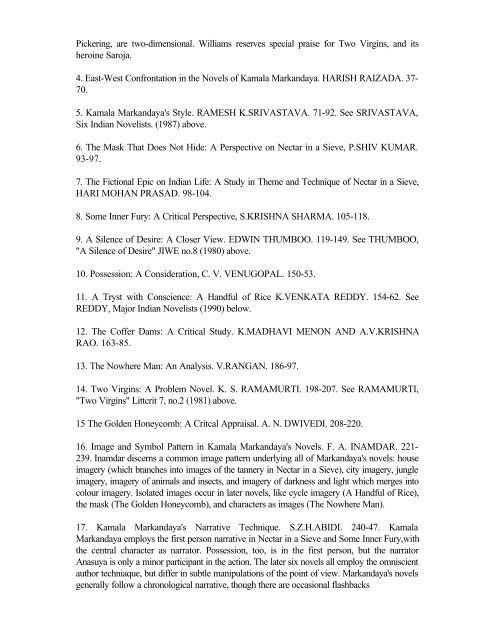india author m 1- a-nan - University of Wollongong
india author m 1- a-nan - University of Wollongong
india author m 1- a-nan - University of Wollongong
Create successful ePaper yourself
Turn your PDF publications into a flip-book with our unique Google optimized e-Paper software.
Pickering, are two-dimensional. Williams reserves special praise for Two Virgins, and its<br />
heroine Saroja.<br />
4. East-West Confrontation in the Novels <strong>of</strong> Kamala Markandaya. HARISH RAIZADA. 37-<br />
70.<br />
5. Kamala Markandaya's Style. RAMESH K.SRIVASTAVA. 71-92. See SRIVASTAVA,<br />
Six Indian Novelists. (1987) above.<br />
6. The Mask That Does Not Hide: A Perspective on Nectar in a Sieve, P.SHIV KUMAR.<br />
93-97.<br />
7. The Fictional Epic on Indian Life: A Study in Theme and Technique <strong>of</strong> Nectar in a Sieve,<br />
HARI MOHAN PRASAD. 98-104.<br />
8. Some Inner Fury: A Critical Perspective, S.KRISHNA SHARMA. 105-118.<br />
9. A Silence <strong>of</strong> Desire: A Closer View. EDWIN THUMBOO. 119-149. See THUMBOO,<br />
"A Silence <strong>of</strong> Desire" JIWE no.8 (1980) above.<br />
10. Possession: A Consideration, C. V. VENUGOPAL. 150-53.<br />
11. A Tryst with Conscience: A Handful <strong>of</strong> Rice K.VENKATA REDDY. 154-62. See<br />
REDDY, Major Indian Novelists (1990) below.<br />
12. The C<strong>of</strong>fer Dams: A Critical Study. K.MADHAVI MENON AND A.V.KRISHNA<br />
RAO. 163-85.<br />
13. The Nowhere Man: An Analysis. V.RANGAN. 186-97.<br />
14. Two Virgins: A Problem Novel. K. S. RAMAMURTI. 198-207. See RAMAMURTI,<br />
"Two Virgins" Littcrit 7, no.2 (1981) above.<br />
15 The Golden Honeycomb: A Critcal Appraisal. A. N. DWIVEDI. 208-220.<br />
16. Image and Symbol Pattern in Kamala Markandaya's Novels. F. A. INAMDAR. 221-<br />
239. Inamdar discerns a common image pattern underlying all <strong>of</strong> Markandaya's novels: house<br />
imagery (which branches into images <strong>of</strong> the tannery in Nectar in a Sieve), city imagery, jungle<br />
imagery, imagery <strong>of</strong> animals and insects, and imagery <strong>of</strong> darkness and light which merges into<br />
colour imagery. Isolated images occur in later novels, like cycle imagery (A Handful <strong>of</strong> Rice),<br />
the mask (The Golden Honeycomb), and characters as images (The Nowhere Man).<br />
17. Kamala Markandaya's Narrative Technique. S.Z.H.ABIDI. 240-47. Kamala<br />
Markandaya employs the first person narrative in Nectar in a Sieve and Some Inner Fury,with<br />
the central character as narrator. Possession, too, is in the first person, but the narrator<br />
Anasuya is only a minor participant in the action. The later six novels all employ the omniscient<br />
<strong>author</strong> techniaque, but differ in subtle manipulations <strong>of</strong> the point <strong>of</strong> view. Markandaya's novels<br />
generally follow a chronological narrative, though there are occasional flashbacks

















